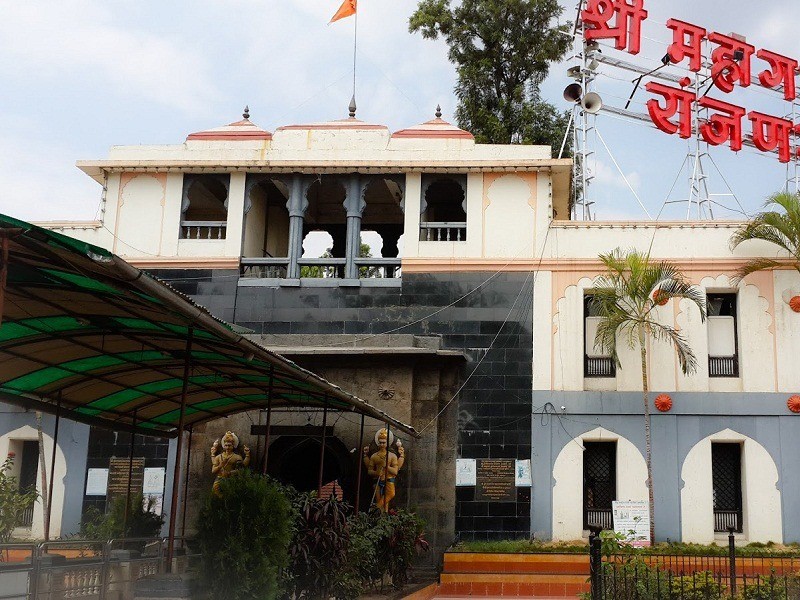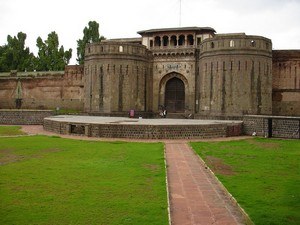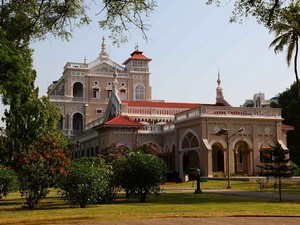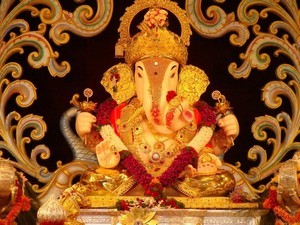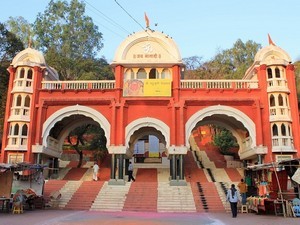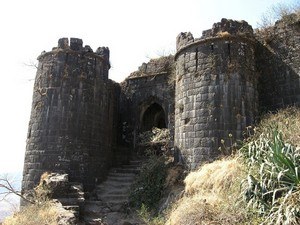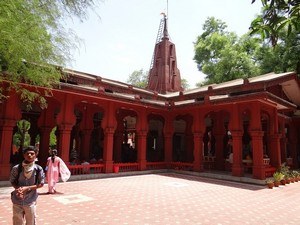Ranjangaon Maha Ganapati Mandir, Pune - Timings, Festivals, History, Darshan, Pooja Timings
Photo Credit: Flickr
 India | Maharashtra | Pune
India | Maharashtra | Pune
 #37 of 66 Places to Visit in Pune
#37 of 66 Places to Visit in Pune
 Distance (From Pune Railway Station): 50 Kms
Distance (From Pune Railway Station): 50 Kms
 Trip Duration (Including Travel): 2-3 Hours
Trip Duration (Including Travel): 2-3 Hours
 Place Location: Rangangaon Village
Place Location: Rangangaon Village
 Transportation Options: Bus / Cab
Transportation Options: Bus / Cab
 Travel Tips: None
Travel Tips: None
About Ranjangaon Maha Ganapati Mandir
At a distance of 50 km from Pune, Ranjangaon Maha Ganapati Temple is a Hindu temple situated at Ranjangaon in the Shirur Taluk of Pune district, Maharashtr. Also known as Sri Maha Ganpati Temple, the temple dedicated to Lord Ganesha, one of the most revered deities in Hinduism. It is one of the eight Ashtavinayak temples venerating Lord Ganesha, bearing immense religious importance in Maharashtra. The other Ashtavinayaka Temples in Maharashtra being Moreshwar in Morgaon, Siddhivinayak in Siddhatek, Ballaleshwar in Pali, Varadavinayak in Mahad, Chintamani in Theur, Girijatmaj in Lenyadri, and Vighneshwar in Ozar. This temple is regarded as one of the most sacred pilgrimage sites near Pune.
History & Mythology of Ranjangaon Maha Ganapati Mandir
The stone pillars of the temple suggest that it was constructed in the 9th or 10th century during the Peshwa dynasty. Madhavrao Peshwa would often stop here on his way to battle, and he created a room in the cellar to house the idol of Lord Ganesha, surrounding it with a stone sanctum. In 1790 AD, he granted an inherited right to perform pooja for Maha Ganapati to Shri Anyaba Dev. Temple hall was built by Sardar Kibe & Owaris (several small apartments erected along the course of enclosing wall of temple) were built by Sardar Pawar & Shinde. The renowned hermit Morya Gosavi presented an idol of Ganesha, crafted from five metals, to Shri Anyaba Dev, which is displayed in parades during festival celebrations. Nagarkhana is located over the entrance gate which was inaugurated by Maharashtra's Chief Minister Shri Manohar Joshi on 3rd May 1997.
Mythology of Ranjangaon Maha Ganapati Mandir
The Maha Ganapati Temple located in Ranjangaon is traditionally regarded as the site where Lord Shiva called upon Lord Ganesha to vanquish Tripurasura. According to local lore, a sneeze from the esteemed saint Grutsamad resulted in the birth of a boy named Tripurasura. He acquired the Ganesh mantra from his father and invoked Lord Ganesha, who granted him the wish of becoming the most powerful being, one whom only Lord Shiva could defeat, after which Tripurasura would achieve liberation. This boon inflated Tripurasura's pride, causing him to wreak havoc across the world. He first conquered the underworld and then the heavens, including the realm of Lord Indra. His ferocity forced Lord Brahma to take refuge in a lotus and Lord Vishnu to hide in the Shirsagar.
In their fear of Tripurasura, the celestial deities sought counsel from Lord Narada. He advised them to pray to Lord Ganapati. Satisfied with their devotion, Lord Ganesh chose to assist the gods. Disguised as a Brahmin, he approached Tripurasura and claimed to be a wise sage capable of creating three flying chariots. With these, Tripurasura could travel anywhere in an instant, and they could only be destroyed by Shiva. In exchange, Lord Ganesh requested the Chintamani statue located on Kailash Mountain. However, Lord Shiva refused to hand over the statue to Tripurasura's envoy. Enraged, Tripurasura himself set out to retrieve the statue, leading to a fierce confrontation with Lord Shiva. He devastated everything associated with Shiva, who retreated to Girikandar. Realizing he could not defeat Tripurasura without first honoring Lord Ganesh, Shiva recited the Shadaakshar Mantra to invoke Ganesh. Upon doing so, he received a special bheejmantra from Lord Gajanana and, with a single arrow, succeeded in slaying Tripurasura.
Architecture of Ranjangaon Maha Ganapati Mandir
The temple faces east and has an imposing main gate which is guarded by two statues of Jaya and Vijay. The temple is designed in such a way that during Dakshinayan, the rays of the sun fall directly on the idol. Like all other Ashtavinayakas, this idol is also considered samshu or self-created. The idol of Lord Ganesh is seated on a lotus with his consorts Siddhi and Riddhi on both sides. He is facing east in a cross legged sitting posture with broad forehead and the trunk turned towards the left. It is said that the original idol is hidden in the basement, having 10 trunks and 20 hands and is called Mahotkat. However, temple trustees have refused existence of such an idol in the cellar.
Festivals of Ranjangaon Maha Ganapati Mandir
Ganesh Chaturthi is the major festival of Maha Ganapati Temple in Ranjangaon. Taking place in August or September, this six-day celebration commemorates the birthday of Lord Ganesha. During this festival, the temple deity is paraded through the vicinity in a palanquin adorned with flowers. The occasion draws large crowds, particularly for the wrestling matches that are specially arranged during this time. Another important occasion is Ganesh Jayanti, observed during the Hindu month of Magha (January/February), which signifies the rebirth of Lord Ganesha. Furthermore, each month, the Sankashti Chaturthi attracts numerous devotees who come to seek blessings.
Dress Code & Other Restrictions of Ranjangaon Maha Ganapati Mandir
Ranjangaon Maha Ganapati Mandir does not enforce a strict dress code; however, it is advisable to wear modest attire that covers the upper arms and legs as a mark of respect. Men are encouraged to don a dhoti or pajama along with an appropriate upper garment, or to wear formal trousers and shirts. Women may choose to wear a saree, half saree, or chudidhars. It is recommended to avoid modern clothing such as mini-skirts, shorts, and sleeveless tops while visiting the temple.
Ranjangaon Maha Ganapati Mandir generally allows non-Hindus to visit and participate in the temple's activities.
Ranjangaon Maha Ganapati Mandir Timings
Monday: 5 AM - 10 PM
Tuesday: 5 AM - 10 PM
Wednesday: 5 AM - 10 PM
Thursday: 5 AM - 10 PM
Friday: 5 AM - 10 PM
Saturday: 5 AM - 10 PM
Sunday: 5 AM - 10 PM
Ranjangaon Maha Ganapati Mandir Entry Fee
Entry is Free
Best Time to Visit Ranjangaon Maha Ganapati Mandir
The ideal period to visit Ranjangaon Ganpati Temple is between August and February, as the weather during this time is pleasant and conducive for temple exploration. Those interested in experiencing the festivities should consider visiting during Ganesh Chaturthi, when the temple is adorned with flowers and lights, and various religious events are held throughout the six-day celebration. However, visitors should note that this is the peak season, leading to larger crowds. For a more tranquil experience, the monsoon months of July to September are suitable that offer a lush and vibrant landscape. It is advisable to steer clear of the summer months due to the intense heat.
How to Reach Ranjangaon Maha Ganapati Mandir
Pune boasts excellent connectivity through air, rail, and road transport. The nearest airport, Pune International Airport, is located approximately 10 kilometers from the city and offers flights to numerous international destinations, including Dubai, Thailand, Malaysia, Singapore, the USA, Europe, and Sri Lanka, as well as domestic routes to major cities such as Mumbai, Hyderabad, Bangalore, Chennai, Delhi, Jaipur, Kochi, Trivandrum, Kolkata, and Goa. Pune Junction Railway Station provides robust train services linking the city to all significant towns and cities across India, including Mumbai, Delhi, Kolkata, Chennai, Hyderabad, and Bangalore. Additionally, Pune is well-served by bus routes connecting it to nearly all cities and towns in Maharashtra, Karnataka, and Telangana. About 50 Km from Pune Junction, Ranjangaon Maha Ganapati Mandir can be easily accessed by state buses or by hiring a cab from Pune.



